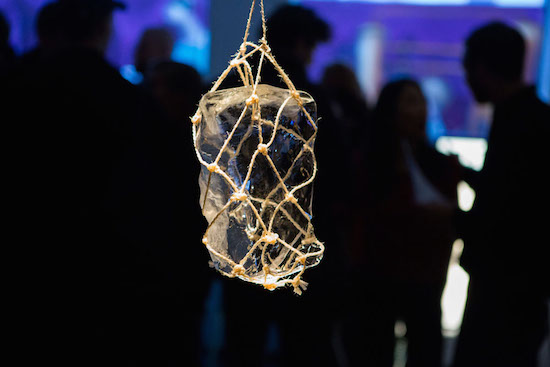Photo credit: Henrik Beck
Bergen is a city that exists between rock, air and water.
The polite Scandinavian streets of picturesque painted wooden houses and later, grander buildings (one particularly fine one with murals of fishing scenes on the walls is now, sadly, the OMG Shot Bar) will, if you look down them, reveal the snub bows of oil rig supply vessels with ungainly names like Bourbon Topaz and REM Vision. Above them, tree-covered slopes rise to rocky summits still covered with ice and a blue sky that suggests spring.
It’s therefore fitting that the first Borealis performance, Tomoko Sauvage’s floe/flow makes sound from water, ice, gravity and minerals. Rough blocks of ice hang suspended from the ceiling by string that cuts into them as they melt. The water falls into china bowls where hydrophones pick up and turn the drips into warm and pulsing tones to hypnotic effect. This is especially so when the eyes are drawn to the blocks of ice themselves: rivulets of water rush down the strings like trains viewed from an aeroplane. Light is refracted and reflected: at the sharp corner of one ice block droplets flash twice tat-tat in quick succession before falling, like seeing a lighthouse far away at night.
Borealis tricks the mind into drawing lines
What’s so striking about this weekend’s festival is just how pleasingly dislocated this line-up is. Curator Peter Meanwell, who previously worked on BBC 3’s excellent Late Junction, tells me that he wanted to programme the festival in the same way as he listens to music, with no boundaries or value judgements made between forms and genre. This is, of course, the Quietus way. Perhaps the mind likes structure, though, and I keep finding myself making simple connections. So the laser projections at mini opera Folie à Deux echo the strings around the blocks of ice earlier on. I catch a line about hydrophones picking up whales flirting in the deep, while the plinks of harp sound like drops falling. It’s an interesting piece, the harps manipulated by shadowy figures at the edge of the performance space. On this monochrome stage cut with thin beams of grey light Sofia Jernberg and Finnur Bjarnason conjure a world of doomed love, murder and loss. Jernberg’s vocal performance is stunning, a voice that can go from soulful pop song to operatic to stuck pig squeal in an instant. For all the lasers and minimalist staging this can very much be taken on face value as an odd musical fairy tale, a love song gone wrong.
Richard Dawson is one of Britain’s finest stand-up comics…
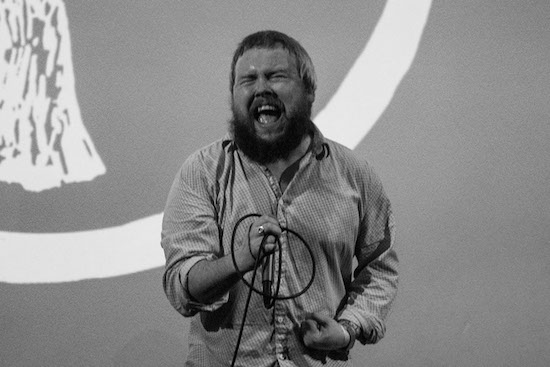
Photo credit: Henrik Beck
…and folk musicians. And story tellers. And artists. And poets. And just everything, really. Gradually divesting himself of layers of clothing as the set progresses, Dawson has a presence quite unlike anyone I’ve seen ever seen play. His records, though brilliant, don’t quite give justice to how these songs come to life when you hear them in the flesh. He’s bent double, face screwed up between his beard and knitted cap, voice ringing out through the room, thudding his feet on the floor. Between songs there are bits of patter about getting cats confused with hedgehogs and electric eels and moths that would be the highlight of the evening at most open mic comedy events. He plays his guitar so it prangs and clangs, strings groaning for a second before they’re snapped taut again. It’s rough and ready, funny and surreal, a performance but never contrived. ‘Poor Old Horse’ is sung acapella and you’re taken to a cold hillside where "the breath of man and beast intermingled" as Dawson makes the agonies of the nag terrifyingly macabre and vivid. There’s such emotional heft to this that by the end the entire room are rabid converts. Dawson invites everyone to Newcastle to stay on his couch… "but no hanky panky".
Contemporary composition works best when it doesn’t try too hard
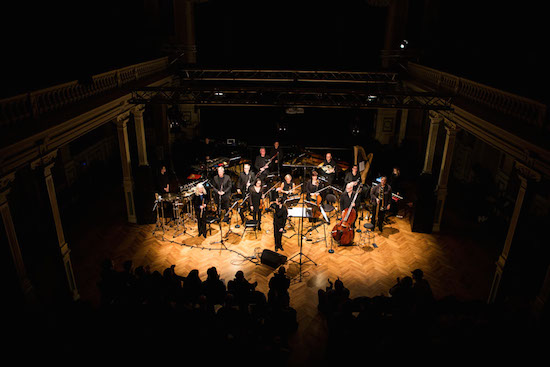
Photo credit: Henrik Beck
There are two very contrasting pieces on Friday night that exemplify what current composers get so right and wrong in their work. First of all, Larry Goves explores the idea of secular prayer and the devotional in music in a beautifully-constructed piece. Strings and trombone are on one side, cello, violin, flute and clarinet on the other. The music seems to sway between them, making the room roll like a tall ship in a swell to the beam. In the second movement the music is decorous before being sandpapered aside by a grating note. It’s quietly done, but you don’t half feel the emotional wrench. We’re promised a ritual element, and each member of the ensemble lights a candle on their music stand before they start playing. A little later, the players on the stage right start wrapping strings around the strings of their instruments before, suddenly, their candles and lights are snuffed out. We’re left with a solitary flame and violin, before darkness. I’d love to know the notation for all that strikingly subtle piece. I’m less sure about Johannes Kreidler’s Living In A Box that follows. There’s a long preamble about this being a comment on "media noise", we’re told about his use of samples from pop music, the confusion between them and the instruments we’ll hear. When you need so much explanation, can the piece work? It sounds fine, like falling down from the top of a Norse mountain in a troll’s picnic hamper, a transistor radio tuned to the local FM station whirling round your head with the pipes and fungi. Yet using pop music samples like this is surely the funding form access box ticking 101 of making contemporary composition ‘relevant’ to a ‘wider audience’ of ‘unengaged stakeholders’, and it comes across, in contrast to Gove’s thoughtful and simple piece earlier, as rather two-dimensional.
It’s good to have to work hard to not be annoyed
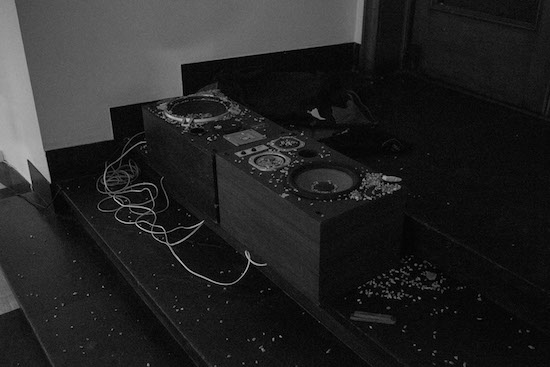
Photo credit: Henrik Beck
Last time I saw Part Wild Horses Mane On Both Sides I was lying on the floor in a dark room at the Wysing Festival. I had a terrible hangover, and there in the blackness was rather soothed by the abstract sounds they generated around me – strange patters of drums, lighting matches, grinding stones. Tonight an aviation hum and a wind somewhere between rush and howl fills the room. Everyone is looking towards the door to the source of the noise, later revealed as two speakers flat on their backs and covered in gravel. The musicians enter the room, and spend the next hour tapping things, rattling things, hitting the odd thing, making a parp, a breath. This is music taken down to beyond any sense of the sum of its parts, music that makes you work very very hard to not instantly dismiss it as being a Vic and Bob sketch mocking the avant-garde. Part Wild Horses Mane On Both Sides success in getting this right is what makes them so fascinating – and anyway, more groups need a rock on slate solo. Less effective, though the audience seem to disagree, are A. Typist. It’s strange that in this digital age the satisfying rattle of a typewriter has become an arcane sound of the past. I remember it as a daily part of life, my dad machine-gunning out sermons with two fingers. There’s a certain odd Proustian recall then in A. Typist’s performance, which use typewriters of varying antiquities to trigger sound and light. I arrive a little late, and watching through the glass door at them typing away around a table is a bit like catching an trio of illicit pamphleteers about their work. Tentative stabs at the keys are followed up by the sound of hastily pattering drums, words spoken in Korean. I must admit I’m a little frustrated by this – I’d loved to have seen more of the mechanical action, which is hidden in the darkness, there’s a lack of dynamic within the set until the final moments.
Borealis knows how to have a hoot with a toot
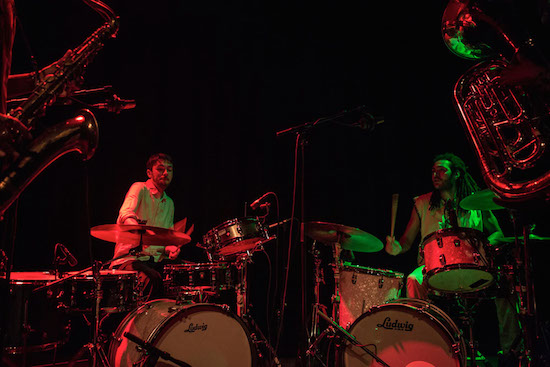
Photo credit: Henrik Beck
Right at the middle of the festival on Friday night there’s a brilliant and sharp contrast to the rest of the weekend with a terrific set from Sons Of Kemet. With two drummers, saxophone and tuba, this is fusion music as it very much should be, a glorious alloy of jazz, rock & roll and sweat. It’s ridiculously good fun, and never feels at odds with the rest of the programming.
Minefields of privilege can be fun to cross
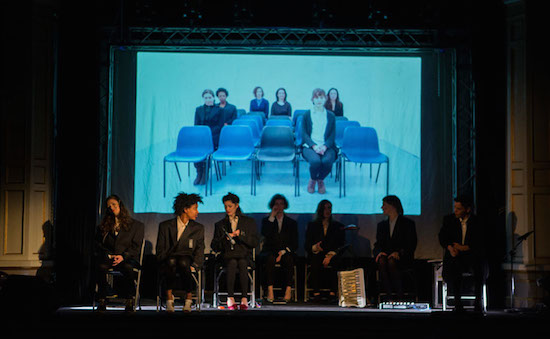
Photo credit: Henrik Beck
On Saturday night, the all-female choir led by Lina Lapelytė and featuring musicians including Anat Ben David and Angharad Davies perform Candy Talk – The Circus, re-contexualising American hip hop tracks. They use sparse electronic accompaniment to turn the sexist lyricism of songs by Public Enemy, Akala and 50 Cent, among others, into choral or folkish pieces that throw into glaring relief the sexist subject matter. Without a more explicit explanation, it’s not clear whether the performers are mocking the artists they’re covering or producing a critique of the social contexts in which the songs were written. It’s arguably not for me to say whether it’s appropriate for a group of largely white women to do this, yet as a bisexual queer man, I’ve always found 50 Cents lyricism problematic and a barrier and I can’t help enjoying this witty subversion. Phew, this is tricky stuff. You can see can see why this can be problematic, especially in this rich country. An arts audience of largely white people finding "more money more money" sung slow and acappella, and therefore sounding ridiculous, amusing. Then again, hearing a Nico-esque voice singing "let me take you to the candy shop / I will let you lick my lolly pop / keep it going / until you hit the spot" while playing the accordion is wonderfully strange. I’d dearly love to see this tour schools, for it does raise important issues and ask difficult questions. What works best is when more politically-charged songs are tackled. Run DMC’s ‘It’s Like That’ for instance suddenly becomes classic soul as a single voice sings "Unemployment at a record highs / People coming, people going, people born to die." It’s a performance that at once makes me feel both slightly queasy and moved, something that rarely happens.
Go North, Life Is F**king Freezing There
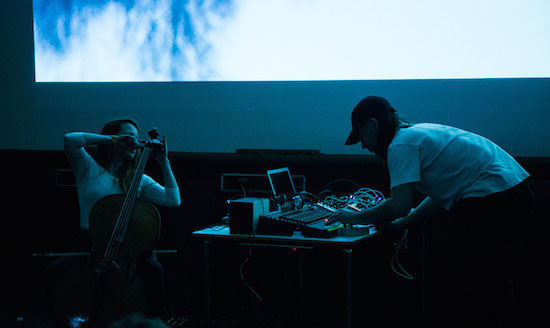
Photo credit: Henrik Beck
Lucy Railton and Russell Haswell wear puffer jackets, warming relics perhaps of the Arctic field trip on which they recorded material for their Saturday night performance. It begins with Railton sat with cello on knees and Haswell lying on the floor as blasts of trebly screeching, like bats pouring out of a cave at night to feast on blood, fill the room. On the screen are images from their trip: girders, ships sailing, ships being fixed or taken apart, rocks inside caves, ice – lots of ice. A sign that announces "Norway’s worst road". A recording of Railton’s cello grinds away like a grumbling, solid and tactile wind, bored of being an inhospitable nuisance. Then, to footage reversed of a snowplough clearing a road they start to play. An instrument as richly acoustic as the cello in the middle of Haswell’s noise really might not work, but tonight it very much does. Drones are often used to reflect on and represent landscape, and this is much like Richard Skelton negotiating with an alien race who’ve landed on the moor behind his cottage and speak in squelches and pops. As well as the dialogue between acoustic and digital it’s the film that really makes the performance – a metal ramp structure rising to a peak on a hill above houses, for once in Norway probably not a ski ramp. It captures the general unrelenting monochrome of the Norwegian and Russian borders – greyish-white ice, snow, sky, vegetation and fauna contrastingly black. More ice. Apparently some Norwegians are nonplussed by all this, feeling it a bit postcards by tourists, but surely this is the point? After all, they sent Haswell and Railton up there as part of this commission. For me, this perfectly evokes the Arctic edgelands of my imagination: an unusual place of displacements of people, nature and ice, never quite fought over in the Cold War when the waters were alive with sonar pings and radar probed the sky.
Borealis will call you out of context
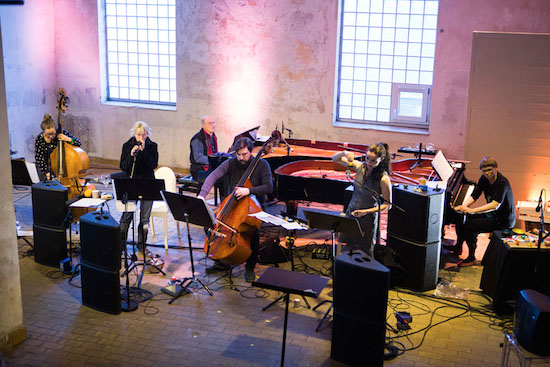
Photo credit: Henrik Beck
On Sunday afternoon the sky is still a rich blue and the northern sun makes for a hot walk to Kjøtt. Yet in the shadows cast by the sheds in Bergen’s docks the ground still has a treacherous sheen of ice. The venue has tiled floors and the paint is peeling off the concrete walls. The radar radome of the cruise ship Oriana is visible through a clear square set into the opaque frosted glass bricks on the seaward wall of the buildings. The musicians performing work by Else Olsen S. and Christian Wolff are scattered around the room amidst the audience, a double bass here, a vocalist there, piano at the back by a window. It’s been advertised as a family day, and children potter around, lean on balloons making them squeak, ask questions in innocently loud whispers, and seem utterly unperturbed by the pattering sounds made by the piano, drones, bells and washes of voice. In the third piece people stand raising their arms as if they’re using semaphore and unleash short shape wails and squawks.
A girl of about three looks up at one of the singers on the balcony, and pours a cone of popcorn into a pot of grapes. Un-popped kernels rattle away across the floor. You could even argue that the occasional child’s yelp even adds to the performance, makes if come alive. It’s one of the most unfussy and engaging stagings of ‘difficult’ contemporary music that I’ve ever encountered
Such is the deluge of easily picked apart music that arrived at the Quietus every day that to wander this quiet town by the fjord and under the mountains from one thing to other is as refreshing as when I wash my wrists in the last of the winter snow after climbing 320 metres to the top of Mount Fløyen. There’s too much context in music today. Knowledge can be a burden and, when you’re faced by a daily bombardment of records by useless indie trouser crusters, familiarity breeds the most vicious contempt. During Borealis, a break from all that, the Norwegian skies were blue, and the strange sounds make the mind shimmer. On the flight over from I was sat next to a retired couple from Norwich who talked enthusiastically about the University Of East Anglia’s electronic music department and plugged my headphones into their iPad (that I’d used 20 minutes after takeoff to take photos of the Norfolk for them, the entire county visible in one screen) to play me Scandinavia’s native Sami music. They were about to start a 22 night ferry journey up the Norwegian coast from Bergen to the Russian border and I wish they’d delayed their trip. They’d have loved this.

